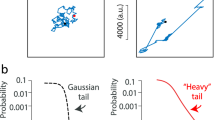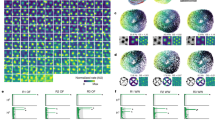Abstract
During navigation, grid cells increase their spike rates in firing fields arranged on a markedly regular triangular lattice, whereas their spike timing is often modulated by theta oscillations. Oscillatory interference models of grid cells predict theta amplitude modulations of membrane potential during firing field traversals, whereas competing attractor network models predict slow depolarizing ramps. Here, using in vivo whole-cell recordings, we tested these models by directly measuring grid cell intracellular potentials in mice running along linear tracks in virtual reality. Grid cells had large and reproducible ramps of membrane potential depolarization that were the characteristic signature tightly correlated with firing fields. Grid cells also demonstrated intracellular theta oscillations that influenced their spike timing. However, the properties of theta amplitude modulations were not consistent with the view that they determine firing field locations. Our results support cellular and network mechanisms in which grid fields are produced by slow ramps, as in attractor models, whereas theta oscillations control spike timing.
This is a preview of subscription content, access via your institution
Access options
Subscribe to this journal
Receive 51 print issues and online access
$199.00 per year
only $3.90 per issue
Buy this article
- Purchase on Springer Link
- Instant access to full article PDF
Prices may be subject to local taxes which are calculated during checkout






Similar content being viewed by others
References
Hafting, T., Fyhn, M., Molden, S., Moser, M. B. & Moser, E. I. Microstructure of a spatial map in the entorhinal cortex. Nature 436, 801–806 (2005)
Moser, E. I., Kropff, E. & Moser, M.-B. Place cells, grid cells, and the brain’s spatial representation system. Annu. Rev. Neurosci. 31, 69–89 (2008)
McNaughton, B. L., Battaglia, F. P., Jensen, O., Moser, E. I. & Moser, M.-B. Path integration and the neural basis of the ‘cognitive map’. Nature Rev. Neurosci. 7, 663–678 (2006)
Giocomo, L. M., Moser, M. B. & Moser, E. I. Computational models of grid cells. Neuron 71, 589–603 (2011)
Zilli, E. A. Models of grid cell spatial firing published 2005–2011. Front. Neural Circ. 6, 16 (2012)
O’Keefe, J. & Burgess, N. Dual phase and rate coding in hippocampal place cells: theoretical significance and relationship to entorhinal grid cells. Hippocampus 15, 853–866 (2005)
Burgess, N., Barry, C. & O’Keefe, J. An oscillatory interference model of grid cell firing. Hippocampus 17, 801–812 (2007)
Hasselmo, M. E., Giocomo, L. M. & Zilli, E. A. Grid cell firing may arise from interference of theta frequency membrane potential oscillations in single neurons. Hippocampus 17, 1252–1271 (2007)
Burgess, N. Grid cells and theta as oscillatory interference: theory and predictions. Hippocampus 18, 1157–1174 (2008)
Giocomo, L. M. & Hasselmo, M. E. Computation by oscillations: Implications of experimental data for theoretical models of grid cells. Hippocampus 18, 1186–1199 (2008)
Hasselmo, M. E. Grid cell mechanisms and function: contributions of entorhinal persistent spiking and phase resetting. Hippocampus 18, 1213–1229 (2008)
Blair, H. T., Welday, A. C. & Zhang, K. Scale-invariant memory representations emerge from moiré interference between grid fields that produce theta oscillations: a computational model. J. Neurosci. 27, 3211–3229 (2007)
Samsonovich, A. & McNaughton, B. L. Path integration and cognitive mapping in a continuous attractor neural network model. J. Neurosci. 17, 5900–5920 (1997)
Fuhs, M. C. & Touretzky, D. S. A spin glass model of path integration in rat medial entorhinal cortex. J. Neurosci. 26, 4266–4276 (2006)
Guanella, A., Kiper, D. & Verschure, P. A model of grid cells based on a twisted torus topology. Int. J. Neural Syst. 17, 231–240 (2007)
Burak, Y. & Fiete, I. R. Accurate path integration in continuous attractor network models of grid cells. PLOS Comput. Biol. 5, e1000291 (2009)
Navratilova, Z., Giocomo, L. M., Fellous, J. M., Hasselmo, M. E. & McNaughton, B. L. Phase precession and variable spatial scaling in a periodic attractor map model of medial entorhinal grid cells with realistic after-spike dynamics. Hippocampus 22, 772–789 (2011)
Alonso, A. & Llinas, R. R. Subthreshold Na+-dependent theta-like rhythmicity in stellate cells of entorhinal cortex layer II. Nature 342, 175–177 (1989)
Giocomo, L. M., Zilli, E. A., Fransen, E. & Hasselmo, M. E. Temporal frequency of subthreshold oscillations scales with entorhinal grid cell field spacing. Science 315, 1719–1722 (2007)
Hafting, T., Fyhn, M., Bonnevie, T., Moser, M. B. & Moser, E. I. Hippocampus-independent phase precession in entorhinal grid cells. Nature 453, 1248–1252 (2008)
Brandon, M. P. et al. Reduction of theta rhythm dissociates grid cell spatial periodicity from directional tuning. Science 332, 595–599 (2011)
Koenig, J., Linder, A. N., Leutgeb, J. K. & Leutgeb, S. The spatial periodicity of grid cells is not sustained during reduced theta oscillations. Science 332, 592–595 (2011)
Welday, A. C., Shlifer, I. G., Bloom, M. L., Zhang, K. & Blair, H. T. Cosine directional tuning of theta cell burst frequencies: evidence for spatial coding by oscillatory interference. J. Neurosci. 31, 16157–16176 (2011)
Yartsev, M. M., Witter, M. P. & Ulanovsky, N. Grid cells without theta oscillations in the entorhinal cortex of bats. Nature 479, 103–107 (2011)
Welinder, P. E., Burak, Y. & Fiete, I. R. Grid cells: the position code, neural network models of activity, and the problem of learning. Hippocampus 18, 1283–1300 (2008)
Giocomo, L. M. & Moser, E. I. Spatial representation: maps in a temporal void. Curr. Biol. 21, R962–R964 (2011)
Barry, C., Bush, D., O’Keefe, J. & Burgess, N. Models of grid cells and theta oscillations. Nature 488, http://dx.doi.org/nature11276 (2012); Reply 488,http://dx.doi.org/nature11277 (2012)
Holscher, C., Schnee, A., Dahmen, H., Setia, L. & Mallot, H. A. Rats are able to navigate in virtual environments. J. Exp. Biol. 208, 561–569 (2005)
Harvey, C. D., Collman, F., Dombeck, D. A. & Tank, D. W. Intracellular dynamics of hippocampal place cells during virtual navigation. Nature 461, 941–946 (2009)
Dombeck, D. A., Harvey, C. D., Tian, L., Looger, L. L. & Tank, D. W. Functional imaging of hippocampal place cells at cellular resolution during virtual navigation. Nature Neurosci. 13, 1433–1440 (2010)
Fyhn, M., Hafting, T., Witter, M. P., Moser, E. I. & Moser, M. B. Grid cells in mice. Hippocampus 18, 1230–1238 (2008)
Brun, V. H. et al. Progressive increase in grid scale from dorsal to ventral medial entorhinal cortex. Hippocampus 18, 1200–1212 (2008)
Sargolini, F. et al. Conjunctive representation of position, direction, and velocity in entorhinal cortex. Science 312, 758–762 (2006)
Witter, M. P. & Moser, E. I. Spatial representation and the architecture of the entorhinal cortex. Trends Neurosci. 29, 671–678 (2006)
Burgalossi, A. et al. Microcircuits of functionally identified neurons in the rat medial entorhinal cortex. Neuron 70, 773–786 (2011)
Quilichini, P., Sirota, A. & Buzsaki, G. Intrinsic circuit organization and theta-gamma oscillation dynamics in the entorhinal cortex of the rat. J. Neurosci. 30, 11128–11142 (2010)
Barry, C., Heys, J. G. & Hasselmo, M. E. Possible role of acetylcholine in regulating spatial novelty effects on theta rhythm and grid cells. Front. Neural Circ. 6, 5 (2012)
Giocomo, L. M. et al. Grid cells use HCN1 channels for spatial scaling. Cell 147, 1159–1170 (2011)
Jeewajee, A., Barry, C., O’Keefe, J. & Burgess, N. Grid cells and theta as oscillatory interference: electrophysiological data from freely moving rats. Hippocampus 18, 1175–1185 (2008)
Tsodyks, M. V., Skaggs, W. E., Sejnowski, T. J. & McNaughton, B. L. Population dynamics and theta rhythm phase precession of hippocampal place cell firing: a spiking neuron model. Hippocampus 6, 271–280 (1996)
Kinkhabwala, A. A. & Tank, D. W. Spatial Patterning of Grid Cell Firing in Virtual Reality Environments. Program No. 100.14/KKK30 (Society for Neuroscience, 2011)
Acknowledgements
We thank C. Harvey, R. Low, A. Miri, S. Lewallen, J. Rickgauer, D. Little, D. Barson, D. Aronov, W. Bialek, I. Fiete and G. Buzsaki for helpful discussions. This work was supported by NINDS grant 5RC1NS068148-02 and 1R37NS081242-01, NIMH grant 5R01MH083686-04, NIH Postdoctoral Fellowship grant F32NS070514-01A1 (A.A.K.), and an NSF Graduate Research Fellowship (C.D.).
Author information
Authors and Affiliations
Contributions
C.D. performed whole-cell recording experiments and histological identification. A.A.K. performed tetrode experiments; A.A.K. and D.W.T. designed the system for measuring grid cell activity in virtual reality; C.D. analysed the data with strategy and methods contributions from A.A.K. and D.W.T.; C.D. and D.W.T. wrote the paper.
Corresponding author
Ethics declarations
Competing interests
The authors declare no competing financial interests.
Supplementary information
Supplementary Figures 1
This file contains Supplementary Figures 1–9. This file was corrected on 27 November 2013. (PDF 22051 kb)
Supplementary Figures 2
This file contains Supplementary Figures 10–27. (PDF 21369 kb)
Supplementary Information
This file contains Supplementary Methods and Supplementary References. (PDF 1059 kb)
Rights and permissions
About this article
Cite this article
Domnisoru, C., Kinkhabwala, A. & Tank, D. Membrane potential dynamics of grid cells. Nature 495, 199–204 (2013). https://doi.org/10.1038/nature11973
Received:
Accepted:
Published:
Issue Date:
DOI: https://doi.org/10.1038/nature11973
This article is cited by
-
A consistent map in the medial entorhinal cortex supports spatial memory
Nature Communications (2024)
-
A distributed and efficient population code of mixed selectivity neurons for flexible navigation decisions
Nature Communications (2023)
-
Ketamine evoked disruption of entorhinal and hippocampal spatial maps
Nature Communications (2023)
-
The grid code for ordered experience
Nature Reviews Neuroscience (2021)
-
Geometry of abstract learned knowledge in the hippocampus
Nature (2021)
Comments
By submitting a comment you agree to abide by our Terms and Community Guidelines. If you find something abusive or that does not comply with our terms or guidelines please flag it as inappropriate.



